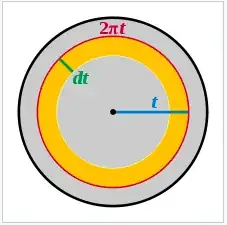I was, as we all were, exposed to the so-called "onion proof" in my first calculus course in high school. Courtesy of this shameless screengrab from wikipedia, the proof can be visualized by integrating across infinitely many, infinitely thin rings which can be approximated by rectangles of length $\ 2πt$ and width$\ dt$.
Now, how can we justify the approximation of the area bounded by the two circular arcs as a rectangle? Is it possible to show unequivocally that:
$\ 2π(t-dt) \times dt$ < area of ring < $\ 2πt \times dt$
for instance, and then apply squeeze theorem as$\ dt$ goes to zero in the limit? I am aware that this approximation is connected to deeper facts about the Jacobian of a polar transformation, but I would like to prove the above inequality with as little machinery as possible (in order to avoid potential circularities in my logic...) If it is not possible to do so rigorously, this feedback would also be appreciated.
